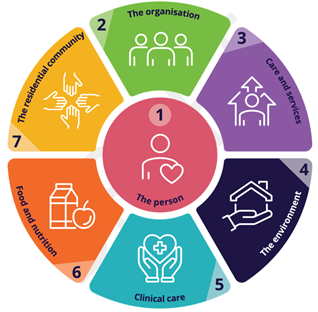Surveillance and Strengthened Aged Care Quality Standards
The strengthened Quality Standards will come into effect from 1 November 2025 in line with the new Aged Care Act and the new regulatory model. Below are extracts from the draft Strengthened Aged Care Quality Standards (February 2025) that especially support the implementation of an infection and antimicrobial use surveillance program.

Standard 2: The Organisation
Intent of Standard
Paragraph 2: The governing body sets the strategic priorities for the organisation and promotes a culture of safety and quality. The governing body is also responsible for driving and monitoring improvements to funded aged care services, informed by engagement with older people, their supporters and aged care workers, and data and information on care quality.
Outcome 2.3: Accountability, quality system and policies and procedures
Outcome statements
Paragraph 2: The provider must use a quality system to enable and drive continuous improvement of the provider’s delivery of funded aged care services.
Paragraph 3: The provider must maintain current policies and procedures that guide the way aged care workers undertake their roles and require aged care workers to follow the policies and the procedures.
Actions
2.3.2: The provider implements a quality system that: d) enables the governing body to monitor the organisation’s performance in delivering quality funded aged care services, informed by iii) Quality Indicator data.
2.3.4: The provider regularly reviews and improves the effectiveness of the quality system.
2.3.5: The provider regularly reports on its quality system and performance to individuals, supporters of individuals and aged care workers.
Outcome 2.4: Risk management
Outcome statement
Paragraph 1: The provider must use a risk management system to identify, manage and continuously review risks to individuals, aged care workers and the provider’s operations.
Actions
2.4.3: The provider collects and analyses data and engages with individuals and aged care workers to inform risk assessment and management. This feeds into the provider’s quality system to improve funded aged care services.
Outcome 2.7: Information management
Outcome statement
Paragraph 1: The provider must ensure that information recorded about an individual is accurate and current, is able to be accessed and understood by the individual, supporters of the individual, aged care workers and health professionals involved in the individual’s care.
Standard 4: The Environment
Intent of Standard
Paragraph 1: To ensure that older people receive funded aged care services in a physical environment that is safe, supportive and meets their needs. Effective infection prevention and control measures are a core component of service delivery to protect older people, their supporters and aged care workers.
Outcome 4.2: Infection prevention and control
Outcome statement
Paragraph 1: The provider must have an appropriate infection prevention and control system
Actions
4.2.1 (b,c,h,i): The provider implements a system for infection prevention and control that is used where funded aged care services are delivered, which (b) prioritises the rights, safety, health and wellbeing of individuals, (c) complies with contemporary, evidence-based practice (h) communicates and manages infection risks to individuals, supporters of individuals and aged care workers and (i) is informed by aged care workers and individual immunisation and infection rates.
Standard 5: Clinical Care
Intent of Standard
Paragraph 1: Providers operationalise the clinical governance framework and report on its performance.
Outcome 5.2: Preventing and controlling infections in delivering clinical care services
Outcome statement
Paragraph 1: The provider must ensure that individuals, aged care workers, health professionals and others are encouraged and supported to use antimicrobials appropriately to reduce risks of increasing resistance.
Paragraph 2: The provider must ensure that infection risks are minimised and, if they occur, are controlled effectively.
Actions
5.2.1: The provider implements an antimicrobial stewardship system that complies with contemporary, evidence-based practice and is relevant to the service context.